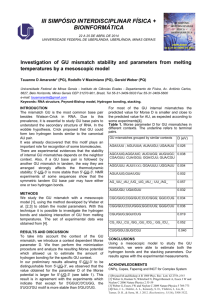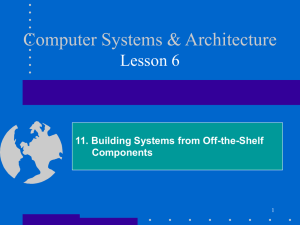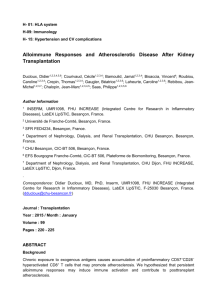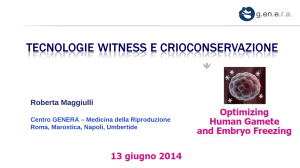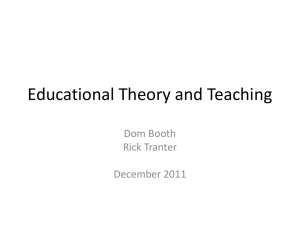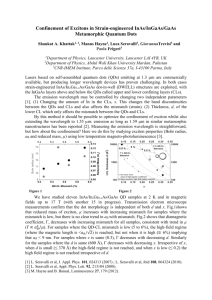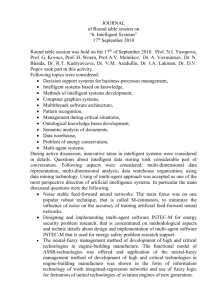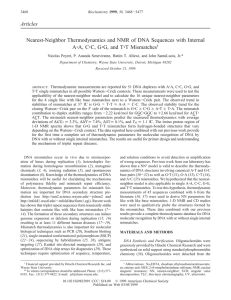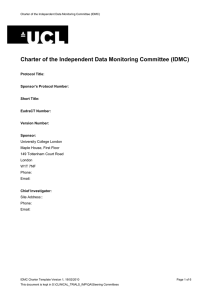petersburg - De Montfort University
advertisement
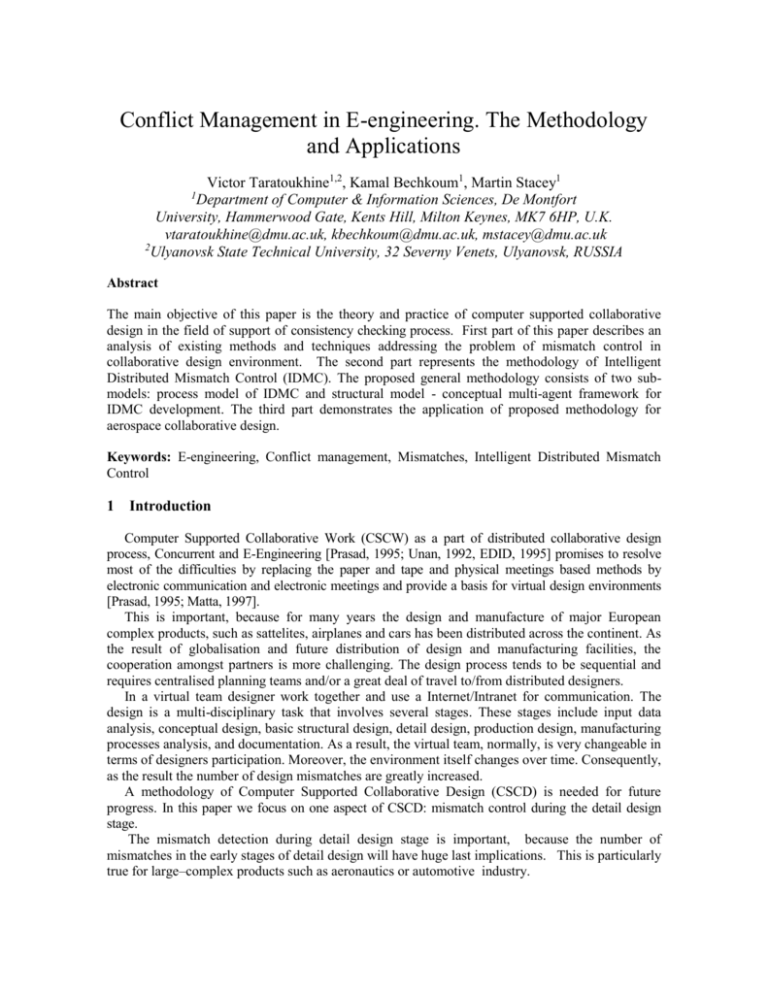
Conflict Management in E-engineering. The Methodology
and Applications
Victor Taratoukhine1,2, Kamal Bechkoum1, Martin Stacey1
Department of Computer & Information Sciences, De Montfort
University, Hammerwood Gate, Kents Hill, Milton Keynes, MK7 6HP, U.K.
vtaratoukhine@dmu.ac.uk, kbechkoum@dmu.ac.uk, mstacey@dmu.ac.uk
2
Ulyanovsk State Technical University, 32 Severny Venets, Ulyanovsk, RUSSIA
1
Abstract
The main objective of this paper is the theory and practice of computer supported collaborative
design in the field of support of consistency checking process. First part of this paper describes an
analysis of existing methods and techniques addressing the problem of mismatch control in
collaborative design environment. The second part represents the methodology of Intelligent
Distributed Mismatch Control (IDMC). The proposed general methodology consists of two submodels: process model of IDMC and structural model - conceptual multi-agent framework for
IDMC development. The third part demonstrates the application of proposed methodology for
aerospace collaborative design.
Keywords: E-engineering, Conflict management, Mismatches, Intelligent Distributed Mismatch
Control
1 Introduction
Computer Supported Collaborative Work (CSCW) as a part of distributed collaborative design
process, Concurrent and E-Engineering [Prasad, 1995; Unan, 1992, EDID, 1995] promises to resolve
most of the difficulties by replacing the paper and tape and physical meetings based methods by
electronic communication and electronic meetings and provide a basis for virtual design environments
[Prasad, 1995; Matta, 1997].
This is important, because for many years the design and manufacture of major European
complex products, such as sattelites, airplanes and cars has been distributed across the continent. As
the result of globalisation and future distribution of design and manufacturing facilities, the
cooperation amongst partners is more challenging. The design process tends to be sequential and
requires centralised planning teams and/or a great deal of travel to/from distributed designers.
In a virtual team designer work together and use a Internet/Intranet for communication. The
design is a multi-disciplinary task that involves several stages. These stages include input data
analysis, conceptual design, basic structural design, detail design, production design, manufacturing
processes analysis, and documentation. As a result, the virtual team, normally, is very changeable in
terms of designers participation. Moreover, the environment itself changes over time. Consequently,
as the result the number of design mismatches are greatly increased.
A methodology of Computer Supported Collaborative Design (CSCD) is needed for future
progress. In this paper we focus on one aspect of CSCD: mismatch control during the detail design
stage.
The mismatch detection during detail design stage is important, because the number of
mismatches in the early stages of detail design will have huge last implications. This is particularly
true for large–complex products such as aeronautics or automotive industry.
The decision is to use Artificial Intelligence (AI)/Distributed AI tools, particulary multi-agent
systems and techniques to provide automatic and semi-automatic mismatch detection and
resolutions [Klein, 1992; Beckoum, 1997; Taratoukhine, 1999].
Many of the recent developments in the field of conflict management have been investigated
and described by Matta, Lander, Klein and others [Matta, 1997; Lander, 1997, Klein, 1992;
Easterbrook, 1991, 2000 ; Bechkoum and Taratoukhine, 1999].
According to [Lander, 1997] there are several ways in which conflict can be managed: such as
Avoidance - Avoid conflict by sharing information about local constraints and priorities; Conflict
classification - Build taxonomy of conflict types. Associated with each conflict type is a specific
piece of conflict resolution advice; Negotiation - Techniques in this area include bargaining,
restructuring, constraint relaxation, mediation, and arbitration.
Below a developments of conflict management methods are represented.
The analysis of current development in conflict management for CSCW sugests that most of of
these methods and frameworks [Klein, 1992], [Matta, 1997], [Easterbrook, 1993] are paid more
attention to social and psychological aspects of communications between members of team, but not
to problems of communications between artificial agents and development a general methodology
of conflict management/intelligent control, based on Distributed AI.
The main objective of this paper is to propose a framework for the development of an Intelligent
Distributed Mismatch Control (IDMC) methodology. This will be based on the integration of two
approaches of conflict management - classification and negotiation. In our case, the classification
and negotiation processes are associated with multi-agent architecture of IDMC.
In this context, the investigation of methods and principles of organisation is as follows:
- Development methodology of Intelligent Distributed Mismatch Control (IDMC). The
proposed general methodology should include:
- Process model of IDMC. Model of taxonomy of mismatches.
- Structural model - conceptual multi-agent framework.
The next step is an application of proposed methodology for CSCD process.
2
Methodology
In order to define a IDMC methodology, the two connected sub-models/levels of formalisation
are used. The first model is process model of IDMC and the second is structural model - conceptual
multi-agent framework, but first of all, we need to define a terminology of consistency checking
process.
2.1 Process Model
In our understanding, the mismatch control is a process of detection and resolution of design
mismatches based on, the on capability of multi-agent framework and communication between
agents, communication and resolutions schemes and distributed knowledge-base organisation.
The Design mismatches are inconsistencies between design goals Gi and current design project
M1(t). Obviously, the goals of design are a set of parameters (for design project) and predefined
restrictions for these parameters. We propose that concurrency attributes are a basis for definition of
restrictions for parameters and structure of design project.
The design mismatches at the detail stage of design are inconsistencies between parameters
restrictions defined according to concurrency attributes, current parameters, and/or the structure of
current design project M1(t). IDMC uses a concept of distributed artificial intelligence - agents.
Agents are represented as “virtual designers” who have internal abilities to receive information, to
identify design mismatches and to prepare advice for the designer to find the best modification to
resolve the mismatch.
Design knowledge model - M2 is used as a personal assistant for the designers D in design team
Dt and helps to detect design mismatches and find the best modifications required.
The design mismatches are detected using a vocabulary of indicators and taxonomy of design
mismatches and resolved using a model M2 - distributed model of designer’s knowledge. We have:
M2= {A1, A2, … , Ai , … , An}; where A- agent.
As can be seen, each agent is represented as part of design assembly and has a knowledge about
assembly part’s geometrical configuration (structure), materials and other parameters.
Ai = {W1, ... , Wi, ... , Wn },
and each agent is represented as single knowledge-base which contains a set of words of designer
to provide a knowledge about different aspects of design, a project, and concurrency attributes.
Each designer world is represented as:
Wi = {K(Mstr), K(Mpar), K(Res), K(Indicators)},
where K- means knowledge, Res- design restrictions, I-indicators. Wi - "i" designer world.
The process model of IDMC is represented as follows:
Modification
of design
project
Advice for
Modification
of project
Designers
Design
Project
M1
Reception of Information
Design Goals
Distributed Knowledge
Distributed
Design Process
Intranet/Internet
Design Process
Design Process
Consistency
checking
Taxonomy of
mismatches
Mismatches of
Integration
Interknowledge
communication
A1,…,An
Restrictions
External
adaptation
Indicators
Figure 1 Process Model of IDMC
Internal
adaptation
According to Fig. 1 the definition of complex taxonomy of design mismatches is important for
the classification and resolution of design mismatches. The development of taxonomy of
mismatches is described in next section.
2.2 Design Mismatches. Classification and Taxonomy
Important developments in this area include models reported by [Klein, 1997], [Matta, 1997],
[Castelfranchi, C (1996)], but these taxonomies, in general, are more oriented towards the
conceptual stage of design process.
We propose a conceptual framework for the development of a taxonomy for detail stage design.
Firstly, we classify design mismatches according the to level/types of information needed for their
detection. We have:
- syntax level - ordinary geometric mismatches (size, diameter, geometric type, parts
orientation,…),
- semantic level - complex assembly mismatches - analysis of geometric and materials
characteristics for checking assembly possibility,
- pragmatic level - the complex mismatches are connected to design/concurrency attributtes,
such as a mismatches of manufacturability, manability, costability, serviceability, etc.
Accordingly, we can define: mismatches of integration and concurrency mismatches.
Mismatches of intergation are assembly mismatches that are necessary to ensure the design at
the integration phase.
Using the proposed model of taxonomy it is possible to define a real taxonomy, for a known
field of implementation (i.e aerospace, automotive, electonics), and a number of concurrency
attributtes - A1, An. Of course, the development of taxonomy is a complicated and long process
which included a definition of critical parameters, indicators, restrictions and attributes and based
on knowledge engineering components, as interviews and questionnaires.
The full taxonomy DFA/DFM mismatches was described in [Taratoukhine, 1999].
Within the proposed taxonomy critical parameters are identified. It is the variation of these
parameters that causes a mismatch. For example, the bolted connection requires consistency
between such parameters as thread minor diameter, minor diameter and pitch (for bolt head type
and assembly tools type). For aircraft wing box bolt and nut – diameter, length and size, etc. Weld
connections require consistency between types of materials and the material thickness, as well as
the geometric parameters of material.
For the mismatch detection process to be more successful, not only we need to represent a wider
variety of mismatch types but we also need to represent geometric information as well as
information about the material which the parts are made of. This taxonomy is restricted by Design
For Assembly(DFA)/Design For Manufacturability (DFM) mismatches. According the taxonomy
development process the criteria of classification should be considered. In our case we have a main
criterion - design for assembly/manufacturability, and additional criteria as types of connections and
indicators (critical parameters- Mparcr).
The next section describes a formal description of structure of multi-agent framework and
dynamics of multi-agent framework.
2.3. The structural model. A multi-agent framework
This section reviews briefly the agent framework and the components within. Using a multiagent approach the representation of the required knowledge is distributed amongst several
“specialised” independent knowledge bases, or agents.
The architecture assumes that the design knowledge is encapsulated within the different
members of the agent community.
The conceptual framework (CF) may be presented formally as follows:
CF = {AP1, ... , APt, ... , APn},
where APt is the tth Assembly Part, t = 1,2, … , n.
AP = {DA1, … , DAi, ... , DAm, CA1, ... , CAj, … ,CAk},
DAi is the ith Design Agent (D-agent), i = 1, 2, …, m,
CAj is the jth Control Agent (C-agent), j = 1, 2, …, k.
Agents exchange information using messages with syntax and semantics defined by the
communication protocol. The context of these messages can include declarative and procedural
knowledge. A reactive agent is an entity that may be represented by an independent program that
knows everything about itself including its relationships with other agents. The principle of
emergence states that intelligence in reactive agents emerges from interaction of agents among
themselves and with their environment. The principle of situatedness states that intelligence of a
reactive agents is situated in the world and not in any formal model of the world build in the agent.
In our case DAi (D-agent) is an reactive agent, which negotiate with other design agents using
design’ schedule (assembly sequence) and scheduling preferences generated and supervised by the
Control Agent (C-agent).
The next section describes inter-agent relationship within framework and communication
between agents. The general structure of conceptual framework communication and adaptation
schemes is shown in Figure 2.
Virtual team of
D
D
designers
C-agents level
CA
CA
CA
D-agents level
M1 i
Design Project
Figure 2 Dynamics of multi-agent framework
3 Application of Methodology
The development of tool for mismatch control is required using the methodology described
above. The proposed software - Intelligent Distributed Mismatch Control System (IDMCS) is
developed and is outlined below.
3.1 IDMCS
The ZEUS toolkit [Hyacinth, Nwana, 1998] was used for the development of IDMCS. The
toolkit provides classes that implement generic agent functionality such as communication,
co-ordination, planning, scheduling, task execution and monitoring and exception handling.
IDMCS analyses designer requirements to the design project given in the form of design
information and processes at the layer of the distributed knowledge base. The system is designed
using JAVA 1.2.1 in the Windows NT environment using ZEUS agents building toolkit. In order to
retrieve/manipulate CAD data on interface from/to PARASOLID geometric kernel is needed and
will be the purpose of future work.
3.2 Case study
One of the key challenges for Europe is to maintain and develop the European Aerospace sector
as a world competitive industry. The European Commission (EC) has fostered several collaborative
research initiatives in aeronautics yielding a number of successful projects. In the Fifth Framework
Programme of the EC the financial support dedicated to the Aerospace industry alone is set to euro
700 million.
Unfortunately the current CAD/CAM/CAE systems do not support the mismatch control
process described here. We are using the IDMCS described above for distributed aerospace design
support.
We are using IDMCS and DFA/DFM taxonomy for development for a distributed knowledgebased design support system which detects geometric and material irregularities at the assembly
stage of aerospace design. The IDMCS provides mismatch control during wing-box assembly
process, using an initial set of data from aircraft design sources [Nui M, 1999] and AIRBUS design
engineers [AIRBUS, 1999].
When designing using IDMCS, the following steps are being performed: (1) analysis of
assembly parts - assembly checks of stringers, skins, spars etc., (2) evaluation of assembly
possibility - Collision and Tolerance Analysis, (3) manufacturability analysis, (4) choosing the
alternatives for mismatch resolution, and (5) semiautomatic mismatch resolution and generation of
results. At the present time, a research version of IDMCS is developed and experiments are under
progress.
4 Conclusion and future work
A novel approach for Intelligent Distributed Mismatch Control as part of Computer Supported
Collaborative Design is developed in this paper.
The methodology of Intelligent Distributed Mismatch Control (IDMC) is outlined. The general
methodology is represented as of two sub-models: process model of IDMC and structural model conceptual multi-agent framework.
Development of IDMCS was outlined as well as the possibility of using IDMCS for aerospace
design.
The future developments of methodology will be in the field of formalisation of the process of
dynamics of conceptual multi-agent framework, based on Automata/Petri Nets, that will provide a
mathematical foundation of adaptation/learning schemes; and to solve a practical problem - future
development of tools for automatic/semiautomatic mismatch control in Computer Supported
Collaborative Design.
References
AIRBUS, (1999), Knowledge engineering at AIRBUS.
Bechkoum. K. (1997), Intelligent Electronic Mock-up for Concurrent Design, Expert Systems with
Applications Journal, Vol. 12, pp. 21-36, (1997).
Bechkoum, K (1997),V. V. Taratoukhine. A Framework for Mismatch Control in a Distributed
Design Environment, Proc. Advances in Concurrent Engineering, Bath, 1-3 September,
Castelfranchi, C (1996) "Conflict Ontology", in Proceedings of ECAI 96, 12th European Conference
on Artificial Intelligence.
Easterbrook, S.,(1994) A. C. W. Finkelstein, J. Kramer, and B. A. Nuseibeh, Coordinating
Distributed ViewPoints: The anatomy of a consistency check. Journal of Concurrent
Engineering: Research and Applications, Vol 2, No 3 (Special Issue on Conflict
Management)
EDID - An Environment for Distributed Integrated Design, Final report, Cranfield University, 1995
Hyacinth, S. (1998), H. Nwana. ZEUS: An Advanced Tool-Kit for Engineering Distributed MultiAgent Systems, Proceedings of PAAM'98, London, March, pp. 377-392, (1998).
Kock N, (2000), Benefits for Virtual Organizations from Distributed Groups, Communications of
the ACM, November 2000/Vol.43, No. 11.
Lander S., (1997) Issues in Multi-agent Design systems, in IEEE Expert, 1997 18-26
Matta, N. (1997), C.Cointe, Concurrent Engineering and Conflict Management Guides, Proceedings
of ICED, Tampere, August 1997
Niu, M (1999), Airframe Structural Design , Conmilit Press Ltd.
Prasad, B.(1995 ), Concurrent Engineering Fundamentals: Integrated Product and Process
Organization, Volume I Hardcover - 502 pages, Prentice Hall,
Klein (1992), M., Supporting Conflict Management in Cooperative Design Teams, Proceedings of
the 11th International Workshop on DAI, Glen Arbor, MI, 1992.
Taratoukhine, V. (1999), K. Bechkoum. Towards a Consistent Distributed Design: A Multi- Agent
Approach, Proc Information Visualisation '99, London, IEEE Press, (1999)
Unan R., (1992) and E. Dean. Elements of Designing for Cost, presented at The AIAA 1992
Aerospace Design Conference, Irvine CA, 3-6 February, AIAA-92-1057, (1992)
